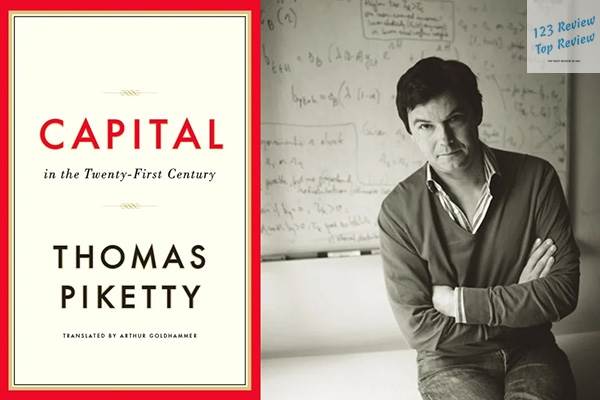The Capital in the Twenty-First Century book examines how economic forces have historically concentrated wealth in the hands of a few, and it explores the implications of this trend for the modern world. Piketty uses extensive data analysis to argue that without significant intervention, the gap between the rich and the rest will continue to grow, challenging the stability of democratic societies.
In this article, 123 Review provides an overview of Piketty’s key arguments, methodology, and the broader impact of his work on economic thought.
Economic Inequality
Historical Trends in Wealth Distribution
In Capital in the Twenty-First Century, Thomas Piketty embarks on an ambitious exploration of economic inequality by meticulously tracing the evolution of wealth distribution over several centuries. Piketty’s analysis is rooted in extensive historical data, which he uses to illustrate how wealth has been distributed among different social classes across various periods. He identifies key epochs, such as the pre-industrial era, the Industrial Revolution, and the post-World War II period, each marked by distinct trends in wealth concentration.

During the pre-industrial era, wealth was predominantly concentrated in the hands of landowners and the aristocracy, with little mobility for the working classes. The Industrial Revolution, however, brought about significant economic changes, leading to the rise of a new class of capitalists who accumulated wealth through industrial enterprises. Despite this shift, the fundamental pattern of wealth concentration persisted, with a small elite controlling a substantial portion of the world’s wealth.
Piketty’s analysis also highlights the post-World War II period as a time of relatively reduced inequality, particularly in Western countries. This era saw the implementation of progressive taxation, social welfare programs, and economic policies aimed at redistributing wealth more equitably. However, Piketty warns that the gains made during this period are being eroded, as the late 20th and early 21st centuries have witnessed a resurgence of wealth concentration, driven by neoliberal economic policies and globalization.
Impacts of Capitalism on Inequality
Piketty’s examination of the relationship between capitalism and inequality forms one of the central pillars of his work. He argues that the dynamics of capitalist economies inherently favor the concentration of wealth. The crux of his argument lies in the observation that the rate of return on capital often exceeds the rate of economic growth. This disparity means that those who possess capital can see their wealth grow more rapidly than the economy as a whole, leading to a widening gap between the rich and the rest of society.
The book explores various mechanisms through which capitalism perpetuates inequality. One such mechanism is the concentration of ownership in capital assets, such as real estate, stocks, and bonds. As these assets generate returns, they disproportionately benefit those who already hold significant wealth. Piketty also discusses the role of globalization in exacerbating inequality, as it has allowed capital to move freely across borders, often to the detriment of workers whose wages remain stagnant.
Moreover, Piketty challenges the notion that capitalism naturally leads to meritocratic outcomes. He argues that the system tends to reward those who already have capital, rather than those who contribute the most to economic productivity. This leads to a situation where wealth begets more wealth, and the economic divide between the rich and the poor continues to grow.
Comparative Analysis of Global Inequality
Piketty’s work is distinguished by its comprehensive comparative analysis of inequality across different regions of the world. He examines how wealth distribution varies between countries and continents, and how these differences are shaped by historical, political, and economic factors. For instance, Piketty contrasts the relatively high levels of inequality in the United States with the more egalitarian distribution of wealth in some European countries.
The book attributes these differences to varying policy choices and social safety nets. In countries with strong welfare states, such as those in Scandinavia, wealth inequality is less pronounced, thanks to policies that promote income redistribution, access to education, and healthcare. In contrast, countries with weaker social safety nets and lower taxation on capital, such as the United States, tend to exhibit higher levels of inequality.
Piketty also discusses the role of emerging economies, particularly in Asia and Latin America, where rapid economic growth has led to both increased wealth and rising inequality. In these regions, the benefits of growth have often been unevenly distributed, with a small elite capturing a disproportionate share of the gains. Piketty’s comparative analysis underscores the importance of policy in shaping the distribution of wealth and highlights the potential for different models of capitalism to produce different levels of inequality.
Theories and Key Concepts
Rate of Return on Capital vs. Economic Growth
One of the most influential concepts introduced by Piketty is the relationship between the rate of return on capital (r) and the rate of economic growth (g). Piketty posits that when the rate of return on capital consistently exceeds the rate of economic growth, wealth becomes increasingly concentrated in the hands of those who own capital. This dynamic, according to Piketty, is a fundamental driver of the persistent and growing inequality observed in capitalist societies.
Piketty provides extensive empirical evidence to support this theory, drawing on data from multiple countries over several centuries. He shows that during periods when the rate of return on capital was high relative to economic growth, such as in the 19th century, wealth concentration increased significantly. Conversely, in the mid-20th century, when economic growth was robust and the returns on capital were relatively modest, inequality decreased.
This theory challenges the optimistic view that economic growth alone can reduce inequality. Piketty argues that without deliberate policy interventions, such as progressive taxation and wealth redistribution, the natural tendency of capitalist economies is towards greater inequality. His analysis has sparked considerable debate among economists, with some supporting his conclusions and others questioning the universality of his findings.
Capital-to-Income Ratio Explained
Another key concept in Piketty’s analysis is the capital-to-income ratio, which measures the total value of capital in an economy relative to its national income. Piketty argues that the capital-to-income ratio is a critical indicator of the degree of wealth concentration within a society. A higher ratio suggests that a larger share of national income is derived from capital, rather than labor, which often correlates with greater inequality.
Piketty traces the evolution of the capital-to-income ratio over time, showing how it has fluctuated in response to economic and political changes. For much of the 19th century, the ratio was relatively high, reflecting the dominance of capital in the economy. However, the 20th century saw a decline in this ratio, particularly in the decades following World War II, as economic growth outpaced the accumulation of capital and income was more evenly distributed.
In recent decades, however, the capital-to-income ratio has been rising once again, particularly in developed economies. Piketty attributes this trend to several factors, including slower economic growth, the accumulation of wealth by a small elite, and the increasing importance of capital in generating income. The rising capital-to-income ratio is a key piece of evidence in Piketty’s argument that inequality is on the rise and that without intervention, this trend is likely to continue.
The Role of Inherited Wealth
Piketty’s analysis also delves into the role of inherited wealth in perpetuating economic inequality. He argues that the accumulation and transfer of wealth across generations are central to understanding the persistence of inequality in capitalist societies. Piketty provides historical data to show that in periods of low economic growth and high returns on capital, inherited wealth tends to play a more significant role in wealth accumulation, leading to greater inequality.
In Capital in the Twenty-First Century, Piketty illustrates how the importance of inherited wealth has varied over time. During the 19th century, for example, inherited wealth was a major driver of inequality, as large estates were passed down through generations. The 20th century saw a decline in the significance of inherited wealth, partly due to the effects of the World Wars, which disrupted the transmission of wealth, and the introduction of progressive taxation on estates.
However, Piketty warns that inherited wealth is once again becoming a dominant factor in wealth accumulation, particularly in developed economies. He argues that this resurgence of inherited wealth threatens to create a new aristocracy, where economic power is concentrated in the hands of a few families, undermining social mobility and perpetuating inequality. Piketty’s analysis suggests that without policy measures to address the concentration of inherited wealth, such as inheritance taxes, the gap between the rich and the poor is likely to widen further.
Consequences of Inequality
Effects on Social Mobility
One of the most profound consequences of economic inequality, as highlighted by Piketty, is its detrimental effect on social mobility. In a society where wealth is highly concentrated, opportunities for upward mobility become increasingly scarce, leading to a rigid class structure. Piketty argues that this lack of mobility is not only unjust but also undermines the social fabric of a society, as it creates a sense of disenfranchisement among those who are unable to improve their economic circumstances.
Piketty draws on data from various countries to show how high levels of inequality correlate with low levels of social mobility. In societies where wealth is concentrated in the hands of a few, the chances of moving up the economic ladder are significantly reduced. This is particularly evident in countries like the United States, where the “American Dream” of upward mobility has become increasingly elusive for many.
The book also discusses the intergenerational transmission of inequality, where the economic status of parents strongly influences the prospects of their children. In societies with high inequality, children from wealthy families have access to better education, healthcare, and social networks, giving them a significant advantage over those from less affluent backgrounds. This perpetuates the cycle of inequality, as the opportunities for upward mobility are skewed in favor of those who are already well-off.
Political Ramifications of Economic Disparities
Piketty argues that the political consequences of economic inequality are equally significant and concerning. He suggests that extreme wealth disparities can undermine democratic institutions, as the wealthy are able to exert disproportionate influence over political processes. This concentration of power can lead to policies that favor the rich, further entrenching inequality and eroding the democratic principle of equal representation.
The book provides examples of how wealth concentration can distort political systems. In countries with high levels of inequality, the wealthy often have the means to lobby for policies that protect their interests, such as lower taxes on capital gains and inheritance. This can lead to a political environment where the voices of the majority are overshadowed by the interests of a wealthy minority, exacerbating social divisions and undermining trust in democratic institutions.
Piketty also explores the potential for economic inequality to fuel political instability. When large segments of the population feel excluded from economic opportunities and believe that the political system is rigged in favor of the rich, it can lead to social unrest and the rise of populist movements. Piketty warns that without addressing the root causes of inequality, these political tensions are likely to intensify, threatening the stability of both democratic and non-democratic regimes.
Psychological and Cultural Impact of Wealth Inequality
Beyond its economic and political consequences, Piketty examines the psychological and cultural impact of wealth inequality on society. He argues that growing disparities in wealth can create divisions within society, leading to increased social tension and a breakdown of social cohesion. The widening gap between the rich and poor can foster feelings of resentment, envy, and alienation among those who are left behind, contributing to a sense of social fragmentation.
Piketty also discusses how economic inequality can shape cultural values and societal norms. In a society where wealth is highly concentrated, there is often a greater emphasis on material success and the accumulation of wealth as a measure of individual worth. This can lead to a culture that prioritizes economic achievement over other forms of success, such as personal fulfillment, social contributions, and community involvement.
The book suggests that this shift in cultural values can further entrench inequality, as it reinforces the notion that economic success is the ultimate goal, and those who fail to achieve it are somehow less worthy. Piketty warns that this mindset can have long-term negative effects on social cohesion, as it creates a society where individuals are judged primarily by their economic status, rather than their character, contributions, or values.
Proposed Solutions
Global Wealth Tax: Rationale and Implementation
One of the most provocative and widely discussed proposals in Capital in the Twenty-First Century is Piketty’s call for a global wealth tax as a means of addressing economic inequality. Piketty argues that such a tax could help curb the concentration of wealth and redistribute resources more equitably across society. He presents a compelling case for the rationale behind this proposal, emphasizing its potential to reduce inequality on a global scale and prevent the formation of new economic aristocracies.
Piketty outlines the mechanics of a global wealth tax, suggesting that it could be implemented as a progressive tax on individual net wealth above a certain threshold. For example, wealth above $1 million could be taxed at a modest rate, with higher rates applied to wealth above $10 million or $100 million. Piketty argues that this approach would target the wealthiest individuals, who are most likely to accumulate significant capital over time, without placing an undue burden on the middle class.
However, Piketty also acknowledges the challenges of implementing a global wealth tax, particularly in terms of international cooperation and enforcement. He discusses the need for global governance structures to oversee the tax, as well as mechanisms to prevent tax evasion and ensure compliance. Piketty suggests that the tax could be coordinated through existing international organizations, such as the United Nations or the European Union, and that it could be linked to efforts to combat tax havens and financial secrecy.
Despite these challenges, Piketty argues that a global wealth tax is both feasible and necessary to address the growing problem of inequality. He points to the success of previous international agreements, such as those on climate change and trade, as evidence that global cooperation on economic issues is possible. Piketty’s proposal has sparked considerable debate among policymakers and economists, with some supporting the idea as a bold and necessary step, while others question its practicality and potential unintended consequences.
Policy Recommendations for Addressing Inequality
In addition to the global wealth tax, Piketty offers a range of policy recommendations aimed at reducing inequality and promoting economic justice. These recommendations are grounded in his extensive analysis of historical and contemporary economic systems, and they reflect his belief that deliberate policy choices are essential to achieving a more equitable distribution of wealth.
One of Piketty’s key recommendations is the implementation of more progressive taxation, particularly on income, wealth, and inheritance. He argues that higher taxes on the wealthy can help redistribute resources, fund public services, and reduce the concentration of wealth. Piketty also advocates for the strengthening of social safety nets, including universal healthcare, education, and social security, to ensure that all individuals have access to the basic necessities of life.
Education is another area where Piketty sees significant potential for reducing inequality. He argues that access to quality education is one of the most effective ways to promote social mobility and level the playing field. Piketty calls for greater investment in public education, particularly at the early childhood and primary levels, to ensure that all children, regardless of their background, have the opportunity to succeed.
Piketty also discusses the importance of labor market policies in addressing inequality. He advocates for stronger labor protections, including minimum wage laws, collective bargaining rights, and regulations to prevent exploitation and discrimination. Piketty argues that empowering workers and ensuring fair wages are essential to reducing income inequality and promoting economic justice.
Alternative Economic Models
In addition to his policy recommendations, Piketty explores alternative economic models that could help address the root causes of inequality. He discusses the potential of social democracies, which combine market economies with strong welfare states, as a means of achieving more equitable wealth distribution. Piketty points to the success of social democratic countries in Europe, such as Sweden and Denmark, which have managed to maintain high levels of economic growth while also reducing inequality through progressive taxation and robust social programs.
Piketty also considers the role of more radical economic models, such as those that prioritize worker ownership and control over the means of production. He discusses the potential benefits of cooperative enterprises, where workers have a direct stake in the success of their companies and share in the profits. Piketty argues that such models could help reduce the concentration of wealth and promote a more democratic and equitable economy.
Finally, Piketty examines the potential for new forms of economic governance, including global institutions that could oversee the implementation of policies to reduce inequality. He suggests that existing international organizations could be reformed or expanded to take on this role, and that new institutions could be created to address the unique challenges of the 21st century. Piketty’s analysis highlights the need for bold and innovative thinking in the face of growing inequality, and he calls for a reimagining of economic systems to create a more just and equitable world.
Critiques and Counterarguments
Reception in the Economic Community
Since its publication, Capital in the Twenty-First Century has sparked intense debate and discussion within the economic community. Piketty’s analysis has been praised by some for its rigorous empirical approach and its focus on the critical issue of inequality. Economists and scholars have lauded Piketty’s ability to synthesize vast amounts of historical data and present a compelling narrative that challenges conventional economic wisdom.
However, Piketty’s work has also faced criticism from various quarters. Some economists have questioned his interpretation of the data, arguing that his conclusions may be overly pessimistic or deterministic. Critics have also pointed out potential flaws in Piketty’s methodology, such as his reliance on historical data that may not fully capture the complexities of modern economies. Additionally, some have argued that Piketty’s focus on wealth concentration overlooks other important factors that contribute to inequality, such as technological change and globalization.
Despite these criticisms, Piketty’s work has had a profound impact on the field of economics and has brought the issue of inequality to the forefront of public discourse. The book has been widely discussed in academic circles, policy forums, and the media, and it has influenced debates on economic policy in countries around the world. Piketty’s analysis has also inspired further research on inequality, as scholars seek to build on his findings and address the questions raised by his work.
Alternative Perspectives on Wealth and Capital
Piketty’s analysis has been met with a range of alternative perspectives from economists who challenge his views on wealth and capital. Some argue that Piketty’s focus on wealth concentration and inequality overlooks the positive aspects of capital accumulation, such as its role in driving innovation, economic growth, and overall prosperity. These critics contend that capital is not inherently problematic, but rather that the key issue is how it is used and distributed within the economy.
For example, some economists emphasize the importance of entrepreneurship and innovation as drivers of economic growth and wealth creation. They argue that the accumulation of capital can provide the resources necessary for investment in new technologies, businesses, and industries, which in turn can create jobs and improve living standards for everyone. From this perspective, the focus should be on creating an environment that encourages innovation and entrepreneurship, rather than on limiting the accumulation of capital.
Others have suggested that Piketty’s analysis may overstate the extent of inequality by focusing on wealth concentration at the top of the income distribution. They argue that measures of inequality should take into account other factors, such as access to education, healthcare, and social services, which can improve overall well-being and reduce disparities in living standards. These critics suggest that a more nuanced approach to inequality is needed, one that considers a broader range of indicators and policies.
Limitations of Piketty’s Analysis
While Piketty’s work has been widely praised for its depth and rigor, it is not without its limitations. Critics have pointed out several areas where Piketty’s analysis may fall short or where his conclusions may be overly simplistic. One of the main criticisms is that Piketty’s reliance on historical data may not fully capture the complexities of modern economies, particularly in the context of globalization, technological change, and shifting labor markets.
For example, some critics argue that Piketty’s focus on wealth concentration overlooks the role of human capital, such as education and skills, in shaping economic outcomes. They suggest that in today’s knowledge-based economy, access to education and skills may be just as important as access to financial capital in determining economic success. From this perspective, policies that promote education and skills development may be more effective in reducing inequality than those focused solely on wealth redistribution.
Another limitation of Piketty’s analysis is that it may not fully account for the diversity of economic systems and institutions around the world. Critics argue that Piketty’s focus on developed economies, particularly in Europe and the United States, may not fully capture the experiences of emerging economies, where different factors may be driving inequality. They suggest that a more comprehensive analysis of global inequality would need to consider a wider range of economic systems, policies, and institutions.
Finally, some critics have raised concerns about the feasibility and potential unintended consequences of Piketty’s policy recommendations, particularly his proposal for a global wealth tax. They argue that such a tax could be difficult to implement and enforce, and that it could lead to capital flight, reduced investment, and slower economic growth. These critics suggest that alternative approaches to addressing inequality, such as targeted social programs or policies to promote economic growth, may be more effective and less disruptive.
Case Studies and Real-World Applications
Examination of Historical Case Studies
Piketty’s analysis is enriched by his examination of historical case studies that illustrate the dynamics of wealth accumulation and inequality over time. He draws on examples from different periods and regions to demonstrate how economic, political, and social factors have influenced the distribution of wealth and the persistence of inequality.
One such case study is the period of the Industrial Revolution in Europe, where rapid economic growth led to significant wealth accumulation by industrial capitalists. Piketty shows how this period was marked by both increased productivity and rising inequality, as the benefits of economic growth were unevenly distributed. The concentration of wealth during this time laid the foundation for the modern capitalist economy and the enduring patterns of inequality that have persisted to the present day.
Piketty also examines the post-World War II period, particularly in the United States and Western Europe, where strong economic growth and progressive taxation led to a reduction in inequality. He highlights the role of policies such as the New Deal in the United States and the welfare state in Europe in promoting more equitable wealth distribution and improving social mobility. However, Piketty notes that these gains have been eroded in recent decades, as neoliberal economic policies and globalization have led to a resurgence of inequality.
Analysis of Contemporary Economic Systems
In addition to historical case studies, Piketty analyzes contemporary economic systems to explore how different models of capitalism have produced varying levels of inequality. He contrasts the relatively high levels of inequality in the United States with the more egalitarian distribution of wealth in countries like Sweden and Denmark, which have adopted social democratic models that emphasize both economic growth and social equity.
Piketty also examines the experiences of emerging economies, such as China and India, where rapid economic growth has been accompanied by rising inequality. He discusses how these countries have grappled with the challenges of balancing economic development with the need to address social disparities. Piketty’s analysis underscores the importance of policy choices in shaping the distribution of wealth and highlights the potential for different models of capitalism to produce different outcomes in terms of inequality.
Insights from Global Economies
Piketty’s work offers valuable insights into the global nature of economic inequality and the ways in which wealth accumulation is influenced by both national and international factors. He discusses how globalization has contributed to the concentration of wealth by enabling the free flow of capital across borders, often to the benefit of wealthy individuals and corporations. This has led to the emergence of global elites who hold significant wealth and power, often beyond the reach of national governments.
Piketty also explores the role of international institutions and agreements in shaping the global economy and influencing patterns of inequality. He discusses the impact of trade agreements, financial regulations, and tax policies on wealth distribution, and how these factors can either exacerbate or mitigate inequality. Piketty’s analysis highlights the need for coordinated global efforts to address the challenges of inequality in an increasingly interconnected world.
Future Implications
Predictions for Wealth Accumulation Trends
Looking to the future, Piketty offers predictions for the likely trends in wealth accumulation and inequality in the coming decades. He suggests that without significant policy interventions, the natural dynamics of capitalism will continue to drive wealth concentration and exacerbate inequality. Piketty warns that the forces of globalization, technological change, and capital accumulation are likely to reinforce existing patterns of inequality, leading to a further widening of the gap between the rich and the poor.
Piketty also predicts that the role of inherited wealth will become increasingly important, as the accumulation of wealth by a small elite leads to the creation of new economic aristocracies. He suggests that this could lead to a resurgence of the “patrimonial capitalism” of the 19th century, where a small number of wealthy families control a large share of the economy. Piketty argues that without policy measures to address this trend, such as inheritance taxes and wealth redistribution, the prospects for social mobility and economic justice will be severely limited.
Long-Term Effects on Economic Systems
Piketty also considers the long-term effects of growing inequality on economic systems and the potential for these trends to undermine the stability and sustainability of capitalism. He argues that extreme inequality can lead to economic stagnation, as the concentration of wealth reduces consumer demand and limits opportunities for investment. Piketty suggests that if current trends continue, the global economy could face a prolonged period of slow growth and social unrest, as the benefits of economic progress are increasingly concentrated in the hands of a few.
In addition, Piketty warns that the concentration of wealth and power could lead to the erosion of democratic institutions and the rise of authoritarianism, as those who are excluded from economic opportunities seek alternative forms of political expression. He suggests that the growing divide between the rich and the poor could lead to a breakdown of social cohesion and the emergence of populist movements that challenge the existing political and economic order.
Potential Pathways for Global Equity
Despite these challenges, Piketty remains optimistic about the potential for creating a more equitable global economy. He argues that with the right policies and international cooperation, it is possible to address the root causes of inequality and promote a more just and sustainable economic system. Piketty suggests that the global wealth tax, progressive taxation, and strong social safety nets could play a key role in reducing inequality and promoting economic justice.
Piketty also calls for a reimagining of global economic governance, with a focus on creating institutions and policies that promote equity and social justice. He suggests that existing international organizations, such as the United Nations and the World Trade Organization, could be reformed to address the challenges of the 21st century, and that new institutions could be created to oversee the implementation of policies aimed at reducing inequality.
In conclusion, Capital in the Twenty-First Century offers a comprehensive and thought-provoking analysis of the dynamics of wealth accumulation and inequality in the modern world. Piketty’s work challenges conventional economic wisdom and calls for bold and innovative thinking in the face of growing inequality. While his analysis is not without its limitations, it has sparked important debates and discussions about the future of capitalism and the potential for creating a more just and equitable global economy.





